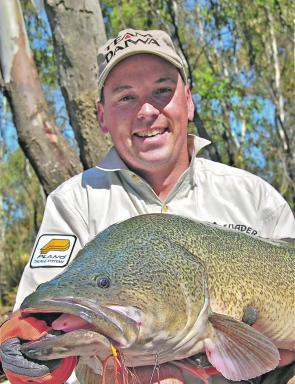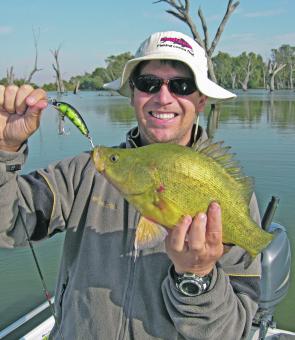As readers may be aware, the Murray Darling Basin Authority released a Draft Basin Plan on the 28 November 2011.
The plan sets out proposed volumes of water for consumptive uses such as irrigation, and those that are required for environmental sustainability. Recreational fishers believe that the plan does not adequately recognise the significance that recreational fishing and healthy fish habitat has on the economic viability of regional communities.
Over the past six months, peak body recreational fishing organisations and other key stakeholders from all states within the Murray Darling Basin have come together to form the Murray Darling Basin Recreational Fishing Council. FFSAQ is a member of the Council. The key focus of the Council is to seek better outcomes for native fish and their habitat, recreational fishers, and thereby contributing to local communities.
The Council has commissioned Ernst & Young to prepare a report called Economic Contribution of Recreational Fishing in the Murray Darling Basin.
The following media release was issued by the Council on 23 November 2011:
A new study confirms recreational fishing as one of the biggest contributors to regional economies in the Murray-Darling Basin.
The newly established Murray-Darling Basin Recreational Fishing Council released a study today identifying recreational fishing as one of the biggest contributors to regional economies in the Murray-Darling Basin.
Chair of the Murray-Darling Basin Recreational Fishing Council, Mr Christopher Collins said: “For the first time, this research highlights the significance of recreational fishing to regional communities in the Basin. On average, recreational fishers go fishing in the Basin 12 times per year, individually spending around $262 each trip.
“With approximately 430,000 fishers in the Basin, recreational fishers spend around $1.3 billion each year when fishing in the Murray-Darling Basin.”
The study also found that recreational fishing contributes approximately $403 million to Gross Domestic Product, and employs around 10,950 people.
“These findings remind us that there’s more to regional communities in the Murray-Darling Basin than irrigation. These results highlight that healthy fish and fish habitats are critical to the economic viability of our regional communities,” said Mr Collins.
With the Murray-Darling Basin Authority planning to release the draft Basin Plan for public comment next week, Mr Collins said: “It is vital that the needs of our native fish communities are met in the draft Basin Plan. When you read the Plan it will be important to consider ‘what is this plan doing for our fish?’ because what you are really asking is ‘what will this plan do for our regional communities?’
“The take home message from this research is a simple, but important one,” Mr Collins said.
“Healthy rivers mean more fish. More fish means more fishers spending money in the Basin. And that is a key ingredient for healthy regional communities.”
Mr Collins represents the Murray-Darling Basin Recreational Fishing Council, an alliance of recreational fishing peak bodies and representatives of the recreational fishing industry throughout the Murray-Darling Basin, who have come together to help ensure the health of our rivers and fish communities in the Basin.
•A new study released identifying recreational fishing as one of the biggest economic contributors to regional economies in the Murray-Darling Basin.
•Study shows that fishers spend around $1.3 billion when fishing in the Murray-Darling Basin.
•Direct value added expenditure (value of wages and profits generated from recreational fishing in the MDB each year) is estimated at $375 million.
•Recreational fishing in the Murray-Darling Basin is estimated to contribute $403 million to Gross Domestic Product (a measurement of the wider economic effect).
•Study shows that recreational fishing in the Murray-Darling Basin makes a significant contribution to employment, supporting approximately 10,950 jobs.
•Results highlight that healthy fish and fish habitats are critical to the economic viability of our regional communities.
•Need to ensure that requirements for fish are met in the draft Basin Plan.
•Key actions that will make a difference to native fish populations and need to be integrated into the implementation of the Plan include: more natural environmental flows o addressing cold water pollution; improved fish passage; screening of irrigation off takes o better weir design and operation; and in-stream habitat rehabilitation.
• Healthy rivers mean more fish. More fish means more fishers spending money in the Basin – a key ingredient for healthy regional communities.
• The Murray Darling Basin Recreational Fishing Council is an alliance of recreational fishing peak bodies and representatives of the recreational fishing industry throughout the Murray-Darling Basin, who have come together to help ensure the health of our rivers and fish communities in the Basin.
• MDBRFC members include VRFish, the Capital Region Fishing Alliance, Native Fish Australia, Freshwater Fishing and Stocking Association of Queensland, NSW Council of Freshwater Anglers Inc., South West Anglers Association Inc. (NSW), Field and Game Federation of Australia, South Australian Recreational Fishing Advisory Council, Australian Fishing Trade Association, and Recfish Australia. – Les Kowitz (FFSAQ)
Reads: 2633





